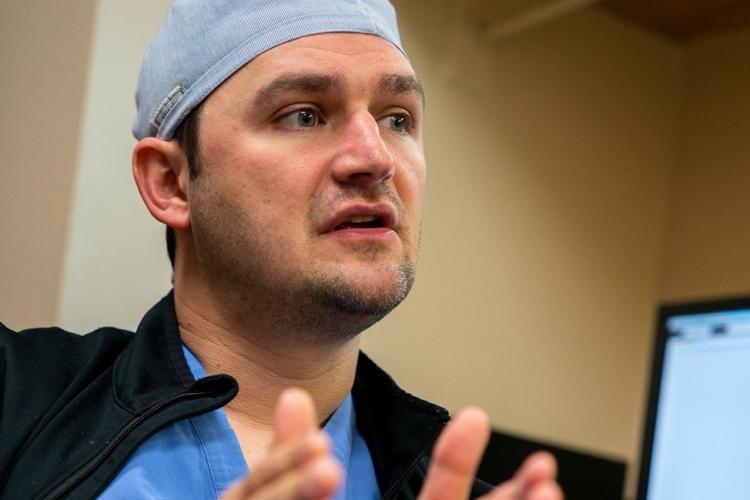
JPS Health Network is on the front lines of the battle against opioid drug use, adopting alternative pain management plans that are proving to be both safer and more effective for patients.
Since September, JPS has reduced the number of narcotic painkillers prescribed to its patients by 22 percent, according to Dr. Richard Teames, Director of Regional Anesthesia at JPS and chairman of the health network’s Pain Stewardship Committee. Over the same period of time, the health network’s Hospital Consumer Assessment of Healthcare Providers and Systems survey scores went up 19 percent.
“One of the reasons I love working at JPS is because I’ve been given the ability to make changes,” Teames said. “Administration and leadership worked hard to set up an environment here where people can make positive things happen, it empowers people and makes them believe ‘I can do this here.’ We’ve been given a chance to try something new – and now we’re seeing the benefits.”
According to Teames, alternative forms of pain control work effectively if they’re managed properly—but they must be given a chance to succeed. Use of non-narcotic pain relievers like Tylenol, non-steroid anti-inflammatory medications including Celebrex, nerve blocks and muscle relaxers combine to create non-addictive, safer forms of pain relief than opioids. For people with persistent pain from medical conditions including arthritis, alternatives like relaxation techniques, massage and touch therapy and yoga can all be effective at managing pain.
An example of the amazing results doctors have produced is the case of a woman who recently had a Whipple procedure at JPS. A complex operation to remove part of the pancreas, part of the small intestine, the gallbladder and the bile duct, Teames said the operation is extremely invasive and exceptionally painful. Usually the patient stays in the hospital for five days after the surgery taking narcotic pain relievers to tolerate the pain while they heal.
The woman was given a nerve block, Tylenol, Celebrex and a muscle relaxer instead—and the pain control plan worked so effectively that she was up and walking the day after surgery—and she felt well enough to go home in two days instead of five.
Dr. Chet Schrader, Vice Chair of the Emergency Department and president of the JPS medical staff, said patients are sometimes skeptical when non-narcotic pain relievers are prescribed because they’re afraid they’re going to be left in agony. They’ve been conditioned to believe narcotics are the only thing that will work to help them, so they don’t want to accept anything else.
“It’s key to have good communication with patients, explaining to them why you’re doing what you’re doing and how the treatment is going to work,” said Schrader. “Sometimes physicians have to stick to their guns when the patients insist they want opioid-based pain killers. But if they can get the patients to give alternatives a chance, the evidence shows they’re likely to be satisfied.”
While over-dependence on narcotics has overshadowed the abilities of other pain control options, Teames said opioids are not really very good at their job. While they are fast-acting agents, their euphoric effects only mask pain for a short period of time, then the patient is left in discomfort wishing for more and more pain relief. Other forms of painkillers have a longer, steadier delivery of relief.
“Tylenol is a mainstay everywhere in the world besides the United States,” Teames said. “It’s very effective if it’s used consistently. It lasts longer than opioids and that’s a key because if you don’t get extended results, you’re not getting good pain control.”
Not only do opioids have a short period of effectiveness after each dose, Schrader said they become even less effective the longer a patient takes them, something that doesn’t happen with other forms of pain relief.
“A patient who initially has significant relief from a relatively mild narcotic will eventually find that they need more and more,” Schrader said. “Stronger narcotics and larger doses over time will produce less significant results.”
Teames said the rise in opioid painkillers in hospitals and doctors’ offices across the United States happened decades ago when it was decided a fifth vital sign should be added to measure a patient’s wellbeing. In addition to their pulse, blood pressure, body temperature and breathing rate, patients were asked about their level of pain. Since it was a measured metric, doctors felt obliged to do something if patients complained they were hurting. Patients learned if they asked for heavy duty painkillers, they were likely going to get them.
Unfortunately, opioids are highly addictive and, since continuously larger doses are required to the same effect, drugs like codeine, fentanyl, hydrocodone, hydromorphone and morphine are abused by patients who find a way to take more than the amount they were prescribed. According to the National Institute on Drug Abuse, 70,237 people died of drug overdoses in the United States in 2017, an increase of nearly 10 percent over the previous year.
“Something has to be done to reduce the national trend of opioid addiction,” Teames said. “We’re doing something at JPS that is making a real difference.”
